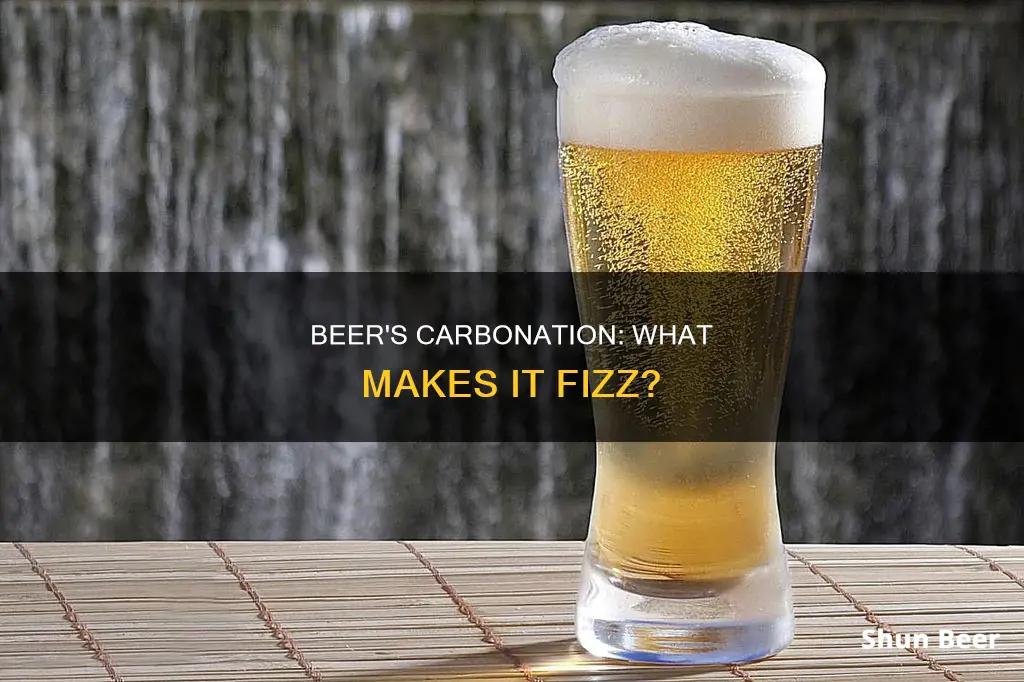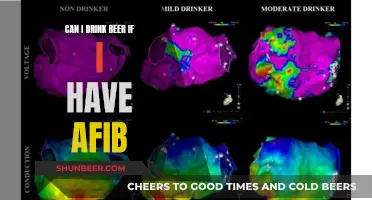
Beer is a unique and refreshing alcoholic beverage with a distinct element of carbonation, resulting in a bubbly texture and a crisp mouthfeel. The carbonation in beer is achieved through two primary methods: natural and forced carbonation. Natural carbonation occurs during the fermentation process when yeast consumes sugar and produces carbon dioxide, while forced carbonation involves pumping carbon dioxide into a sealed container with the beer. The carbonation gives beer its fizz and contributes to its overall character. While most beers are carbonated, there are also non-carbonated and low-carbonated varieties, such as nitro beers and cask-conditioned beers, which offer a different flavour profile and mouthfeel. The carbonation in beer not only enhances its sensory appeal but also plays a crucial role in preserving its freshness and extending its shelf life.
What You'll Learn
- Beer can be carbonated naturally or via forced carbonation
- Natural carbonation occurs during the fermentation process
- Forced carbonation involves pumping carbon dioxide into a sealed container
- Beer must be fully sealed to maintain carbonation
- Non-carbonated beers include nitro beer and cask-conditioned beer

Beer can be carbonated naturally or via forced carbonation
Beer is indeed a carbonated drink, although some may disagree due to the fact that it is not commonly referred to as a "fizzy drink". Beer can be carbonated in two ways: natural carbonation and forced carbonation.
Natural carbonation occurs when yeast consumes sugar and creates carbon dioxide during the fermentation process. In the fermentation vessel, the carbon dioxide has nowhere to escape, so it dissolves into the beer and transforms into carbonic acid (liquid form of carbon dioxide). During this process, the carbonic acid binds to the flavour and aroma compounds in the beer. Once the pressure of the fermentation vessel is relieved, as when opening a bottle of beer, the carbon dioxide rises to escape and forms bubbles. The process of natural carbonation creates tinier bubbles, a finer head on the beer, and a softer, more rounded taste in the beer.
Forced carbonation occurs when carbon dioxide is pumped into a sealed container with the beer and absorbed into the liquid. This method is used for large commercial beers to speed up production and allow faster batch production. Forced carbonation can also occur in small-batch brewing, including craft and home-brewed beer.
Some beers are carbonated using a combination of both methods. For example, some beers are dry-hopped, which means that hops are added at the end of fermentation, so the beer cannot be fully carbonated during this process. However, brewers may still try to get some natural carbonation in their beers at one stage or another throughout the different processes.
Understanding Beer Screens: The Science Behind the Suds
You may want to see also

Natural carbonation occurs during the fermentation process
Beer is typically a carbonated drink, although non-carbonated and low-carbonated varieties do exist. Carbonation is the process of adding carbon dioxide to a beverage, creating a "fizzy" effect. This can be achieved through natural or forced carbonation.
During the fermentation process, yeast consumes sugars and produces alcohol and carbon dioxide. While most of the carbon dioxide is allowed to escape, brewers will seal the beer in a container towards the end of the process. This can be done in holding vessels at the brewery, in casks, or in bottles. In the case of bottle conditioning, a small amount of sugar is added to the beer after it has fermented and the bottles are sealed. The remaining yeast then acts on the sugar, releasing carbon dioxide that is absorbed by the beer.
Natural carbonation results in smaller bubbles and a softer, rounder taste compared to forced carbonation. It also includes processes such as keg conditioning, bottle conditioning, and spunding. Some breweries prefer natural carbonation for the taste, mouthfeel, and environmental benefits it offers.
The Beer Hall Putsch: What If It Succeeded?
You may want to see also

Forced carbonation involves pumping carbon dioxide into a sealed container
Beer is typically a carbonated drink, with carbonation giving beer its distinctive bubbles and fizz. This carbonation can be achieved through natural or forced carbonation.
Forced carbonation is a process that involves pumping carbon dioxide into a sealed container with the beer. This method is often used for kegs, and it is a common technique for large commercial beers and small batch brewing. The beer is allowed to fully ferment, and then carbon dioxide is pumped into the sealed container. After a few days, the carbon dioxide is absorbed into the beer, creating a fully carbonated beverage.
To achieve the desired level of carbonation, the correct pressure of CO2 must be applied and regulated to prevent the gas from escaping. Charts are available to determine the precise pressure required. Once the desired pressure is reached, the tank is sealed and allowed to sit for several days to ensure the beverage is fully carbonated.
This process of forced carbonation differs from natural carbonation, which occurs during the fermentation process. During fermentation, yeast consumes sugar, creating carbon dioxide and alcohol. The brewer seals the beer in a container before fermentation is complete, trapping the carbon dioxide and creating natural carbonation.
While forced carbonation can enhance the drinking experience, it is important to monitor CO2 levels during this process, as an increase in CO2 of just 0.5% can have adverse effects on the human body, including headaches, drowsiness, and nausea.
Sober People and Non-Alcoholic Beer: A Safe Choice?
You may want to see also

Beer must be fully sealed to maintain carbonation
Beer is a carbonated beverage, with carbonation achieved through either natural or forced carbonation. Carbonation is the process of adding carbon dioxide to a liquid, creating a "fizz" and contributing to the mouthfeel of the drink. To keep the carbon dioxide in the beer, pressure is required, which is achieved through a sealed bottle cap or tab. Therefore, to maintain carbonation, beer must be fully sealed.
Natural carbonation occurs during the fermentation process, when yeast consumes sugar and creates carbon dioxide. During this process, most of the carbon dioxide is released, but the brewer can choose to seal the beer in a container before the process is complete, allowing leftover yeast and additional sugars to continue producing carbon dioxide. This method is often used for beer in holding vessels at breweries and in casks. Another way to achieve natural carbonation is to allow the beer to fully ferment, then add a small amount of sugar at bottling time. Once the bottles are sealed, the yeast will act on the sugar, releasing carbon dioxide that is absorbed by the beer.
Forced carbonation, on the other hand, involves allowing the beer to fully ferment, then pumping carbon dioxide into a sealed container with the beer. This method is commonly used for kegs, and the beer is refrigerated during the process. Over a few days, the carbon dioxide will be absorbed into the beer, fully carbonating it.
To maintain carbonation, beer must be fully sealed with a tight bottle cap or sealed container. This ensures that no carbon dioxide escapes until the beer is opened. Once opened, beer should be consumed within a few hours, as the carbonation will dissipate, causing the beer to taste different and go flat.
Most beers with a low alcohol by volume (ABV) percentage can be stored unopened for about six months before they risk losing their carbonation. However, beers with a higher ABV are often made for aging, and leaving them unopened for a few years can improve their flavour. These include beers such as lambics, stouts, sours, and porters.
Beer and Lipitor: Safe Mix or Health Risk?
You may want to see also

Non-carbonated beers include nitro beer and cask-conditioned beer
Beer is typically carbonated, but there are non-carbonated and low-carbonated options available. Non-carbonated beers are any brews with little to no carbon dioxide, which results in no carbonation levels in the beverage. While this may sound unappealing, the fermentation process produces a base level of carbonation that gives the drink a softer and less abrasive mouthfeel.
Cask-conditioned beer, also known as cask ale or real ale in the UK, is brewed and served directly from a cask. The beer undergoes a traditional packaging and serving method that significantly reduces carbonation. Cask ales are unfiltered, unpasteurised, and have a creamy texture. They also have a unique flavour profile due to the natural carbonation process, which produces finer, smaller bubbles that give a cloud-like effect in the mouth.
Non-carbonated beers are becoming increasingly popular among craft beer drinkers and enthusiasts, especially those who want to reduce their carbonated beverage intake for health reasons. While they may have a lighter and weaker taste than carbonated beers, non-carbonated beers offer a smooth and unique drinking experience.
Insulin and Beer: Is It Safe to Drink?
You may want to see also
Frequently asked questions
Yes, beer is carbonated. Carbonation is the carbon dioxide gas in a liquid, and beer is carbonated through either natural or forced carbonation.
Natural carbonation occurs when yeast consumes sugar and creates carbon dioxide during the fermentation process.
Forced carbonation occurs when carbon dioxide is pumped into a sealed container with the beer and absorbed into the liquid.







